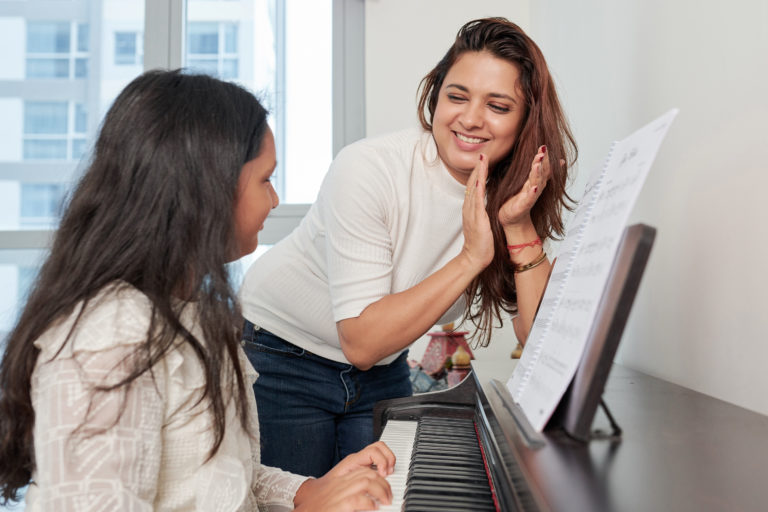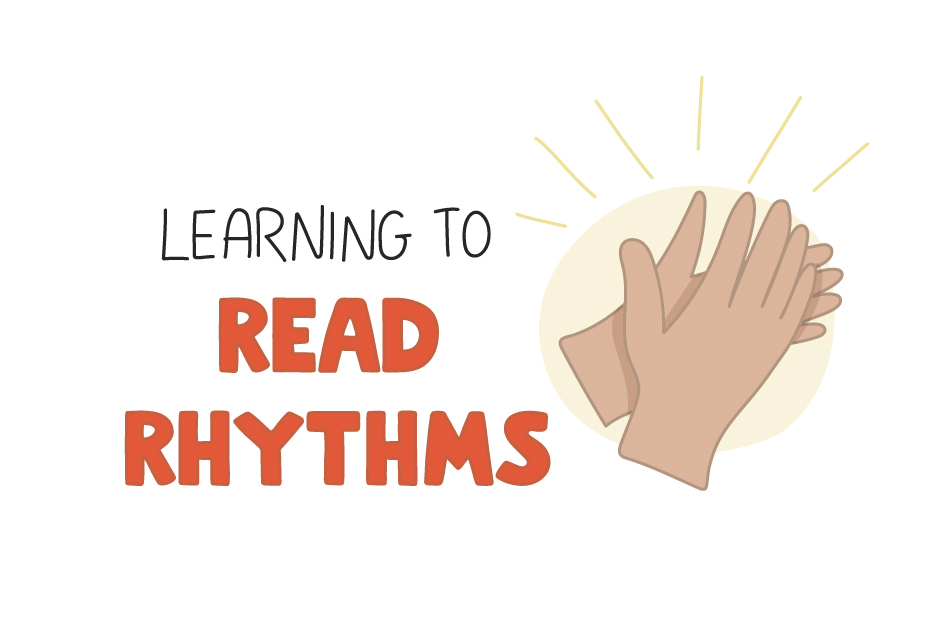In an earlier post, I talked about helping kids develop their natural sense of beat, and also shared some activities that let kids listen to and repeat rhythms. After establishing this foundation, kids are ready for the next step, which is learning how to read rhythms in music.
Ready for Reading Rhythms
I feel that reading rhythms is often taught backwards. A music student is shown the notes, told how many counts each one gets, and then asked to tap or clap out an unfamiliar rhythm. Why is this backwards? If you think about the way a child usually learns to read, you don’t start out by showing them the alphabet, telling them the sound for each letter, and then asking them to decipher words. What do you do first? You read to them. You make the sounds for them while they’re looking at the words. A time comes to learn the sounds of each letter and to be able to decode unfamiliar words, but that’s a more advanced skill.
Rhythm Story
When using this more natural method to teach children about reading rhythms, don’t worry about how many counts each kind of note gets. Show your child a simple rhythm and clap or chant it for them, then have them clap or chant along with you. I call this “Rhythm Story” because it is like reading a storybook together. Do this with lots and lots of different rhythms. It would be a good idea to make this a part of a beginning student’s daily practice routine. A great tool to use for this exercise is the heartbeat mat and notes which you can find at our Hoffman Academy Store. You can also create your own heartbeat mat and notes by copying the one I use in my video lessons.
What if you don’t know how to read rhythms yourself? No problem! All you need is to find the sheet music for a familiar song. Simple children’s songs work best when you’re starting out. Choose a song that you and your child are familiar with, like “Row, row, row your boat” or “Twinkle Twinkle Little Star.” As you look at the sheet music together, chant the lyrics while you point to the notes on the staff. The “Wee Sing” books are a great resource for this activity.
How to Read Rhythms in Music
Reading rhythms in music is a complex skill, but it can be learned! The key to reading rhythms is to start simple, break the skill down into smaller parts, listen, practice, and repeat.
Rhythm in music is essentially the way that even measures of time are subdivided into segments of various lengths. So, the first thing to work on is developing a sense of those even measures of time, or in other words, learning to keep a steady tempo. One great way to do this is with the Hoffman Academy Heartbeat Mat. Each heart on the mat represents one beat. With the mat in front of you, starting on the top row and moving left to right, touch each heart and say “ta” in an even tempo. To be sure your tempo is even, use a metronome and touch and speak on each click. When you can point and speak slowly, set your metronome to a faster tempo. This might be tricky at first, or it might seem easy to you, but it’s an important part of learning to read rhythms so keep trying until you can do it.
Ready with a steady beat? Now it’s time to introduce notes with different rhythms. You can download and print this set of FREE rhythm cards, or make your own. The shape of each note will tell you how many beats or fractions of a beat to hold each note before moving on to the next.
Once you can do this easily with the heartbeat mat, get out a piece of sheet music. It’s best if you choose a song you’re familiar with so you’ll already know the rhythm. At first, don’t worry about what the notes say. You’re just going to tap and speak the steady tempo. Look at the time signature. Whatever the top number is, that’s how many “ta’s” you’ll be tapping and speaking in each measure. Start at the beginning of the piece and work your way to the end, just tapping and speaking on a steady beat.
Got that? Now it’s time for a real challenge. Can you tap a steady beat with your finger while chanting the rhythm of the song? Say the lyrics out loud, or use a neutral syllable like “la.”
How to Read Rhythms in Music with Visual Rhythm Games
Here are some more visual rhythm games you can play:
Dictation: Ask your child to write out or put on the heartbeat mat the rhythm for a song they know well. You can also clap or chant an unfamiliar rhythm for them to write out or put on the heartbeat mat.
Find my Rhythm: Using any piece of sheet music, choose a small section and clap or play the rhythm. Have your child pick out which rhythm they heard.
Rhythm Challenge: You clap a steady beat while your child claps a written rhythm. Start with familiar rhythms, and then eventually you can try this activity with rhythms your child hasn’t heard before.
Composition: Have your child write out or arrange on the heartbeat mat a rhythm of their own making, and then clap or chant it for you. For an example of how to do this, watch this video lesson:
By giving your child lots of opportunity to associate the shapes of written notes with the sound of the rhythms they represent, you are helping them be ready for the final phase of mastering rhythm in music, counting!




